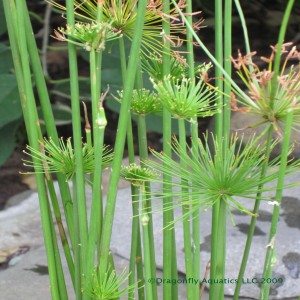 Dwarf Papyrus is a perfect plant for tub gardens or table top container ponds. While the dwarf is a perfect smaller plant for container gardening or smaller ponds if you have a large pond you might want to stick with the larger variety, Dwarf Giant Papyrus which grows about 3 ft tall.
Dwarf Papyrus is a perfect plant for tub gardens or table top container ponds. While the dwarf is a perfect smaller plant for container gardening or smaller ponds if you have a large pond you might want to stick with the larger variety, Dwarf Giant Papyrus which grows about 3 ft tall.
Our Dwarf Papyrus are really nice plants this year. Each now approximately 12" high. This plant is compact with tight tufts of green strands on top of the stems. Height 12-18 inches and spread about 6-12 inches. It requires sun to part shade and moist soil or water up to 4 inches deep.
Dwarf Papyrus is viviparous and will grow new plants from the tops. You can easily winter this plant over indoors as a houseplant in a sunny spot as long as you keep the soil moist at all times but don't submerge the crown. You would want to keep the winter temperature above 50 degrees.
Buy Dwarf Papyrus,bog plant here.
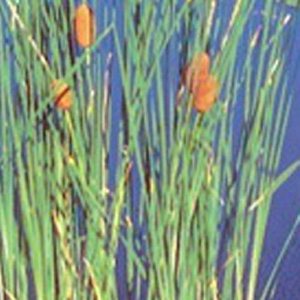 Dwarf Cattails are popular with most of our customers. They are ideal for smaller ponds and container water gardens as well as the regular ponds. They grow in sun to part shade in moist soil or water to just 5 inches deep. Dwarf cattails grow to only about 36 inches in height and do well in Zones 3-10 and will tolerate water over their crown. The foliage on the dwarf cattail is very narrow and it has small catkins. Cattails can be grown from seed, but they propagate quickly from dividing their rhizomes.
Dwarf Cattails are popular with most of our customers. They are ideal for smaller ponds and container water gardens as well as the regular ponds. They grow in sun to part shade in moist soil or water to just 5 inches deep. Dwarf cattails grow to only about 36 inches in height and do well in Zones 3-10 and will tolerate water over their crown. The foliage on the dwarf cattail is very narrow and it has small catkins. Cattails can be grown from seed, but they propagate quickly from dividing their rhizomes.
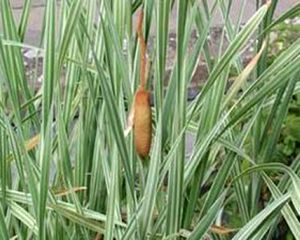 Variegated cattail, Typha latifolia 'Variegata' is an attractive bog plant for any pond. The variegation in this cattail is bold forming bright green and white longitudinal stripes. The Variegated Cattail will grow to 5 feet tall in sun to part shade. It requires moist soil or water to 12 inches deep. It does well in Zones 4-11. The Variegated Cattail doesn't grow as readily as the other cattails and doesn't like to be transplanted.
Variegated cattail, Typha latifolia 'Variegata' is an attractive bog plant for any pond. The variegation in this cattail is bold forming bright green and white longitudinal stripes. The Variegated Cattail will grow to 5 feet tall in sun to part shade. It requires moist soil or water to 12 inches deep. It does well in Zones 4-11. The Variegated Cattail doesn't grow as readily as the other cattails and doesn't like to be transplanted.
The Variegated Cattail is a nice addition to any pond and provides a taller backdrop for smaller plants around your pond. In addition, it also is a great pond plant that will attract dragonflies and other wildlife to your water garden.
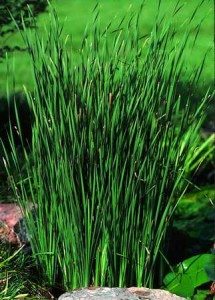 Graceful Cattails, Typha angustifolia are similar to your regular Common Cattail other than its leaves. They are more narrow leafed than the standard and the foliage arches and sways gracefully in the breeze. An elegant bog pond plant and is suitable for any pond or large container water garden. They will grow 4-6 feet tall and their catkins are very thin. The foliage makes an attractive cutting for any floral arrangement.
Graceful Cattails, Typha angustifolia are similar to your regular Common Cattail other than its leaves. They are more narrow leafed than the standard and the foliage arches and sways gracefully in the breeze. An elegant bog pond plant and is suitable for any pond or large container water garden. They will grow 4-6 feet tall and their catkins are very thin. The foliage makes an attractive cutting for any floral arrangement.
Graceful Cattails grow in sun to part shade in moist soil to water 12 inches deep and do well in Zones 3-11. They don't mind having water above their crown even during winter months and tolerate freezing temperatures well. Again Graceful Cattails are the same as other cattails and will propagate quickly from division of the rhizomes or easily grown by seed.
 Some of you further north of us, are already getting some chilly nights. The leaves on your trees are already showing the colors of fall. Here, in Ohio things are just beginning to change. In the past week, I've noticed a few splotches of color. Before the leaves begin to fall, cover your pond with one of our pond covers. The goal is to try and keep the pond as clean as possible for the winter months. Leaves will sink to the bottom of the pond and rot, causing excess carbon dioxide and hydrogen sulfide. After the first frost, take out any floating plants, as these will begin to decay. Trim back hardy lilies and place below the freeze line. Trim foliage back on your hardy bog plants. Not all bog plants need to be submerged, some will be fine where they are. Check out each plants individual needs to ensure they re-appear in the spring for you.
Some of you further north of us, are already getting some chilly nights. The leaves on your trees are already showing the colors of fall. Here, in Ohio things are just beginning to change. In the past week, I've noticed a few splotches of color. Before the leaves begin to fall, cover your pond with one of our pond covers. The goal is to try and keep the pond as clean as possible for the winter months. Leaves will sink to the bottom of the pond and rot, causing excess carbon dioxide and hydrogen sulfide. After the first frost, take out any floating plants, as these will begin to decay. Trim back hardy lilies and place below the freeze line. Trim foliage back on your hardy bog plants. Not all bog plants need to be submerged, some will be fine where they are. Check out each plants individual needs to ensure they re-appear in the spring for you.
Get your pond cover, de-icers here.
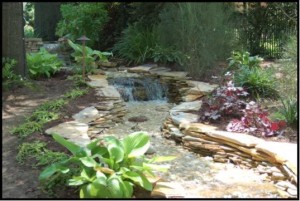 Isn't the sound of a waterfall a sound of pure relaxation. This is a waterfall created and designed by Appalachian Dreams. Its just one of many of his creations. There are many ways to create that space in your yard that brings pure enjoyment and relaxation.
Isn't the sound of a waterfall a sound of pure relaxation. This is a waterfall created and designed by Appalachian Dreams. Its just one of many of his creations. There are many ways to create that space in your yard that brings pure enjoyment and relaxation.
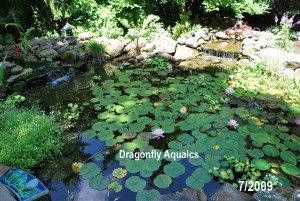 There are some essential tasks to take care of during the summer while enjoying your pond. Water plants can outgrow their containers during the warm summer months. If your waterlilies are covering too much pond surface, simply prune outer leaves of the lily down to half their spread. You will want to remove dead lily pads and spent flowers. These not only create an unsightly appearance but decaying matter will create other problems in your pond.
There are some essential tasks to take care of during the summer while enjoying your pond. Water plants can outgrow their containers during the warm summer months. If your waterlilies are covering too much pond surface, simply prune outer leaves of the lily down to half their spread. You will want to remove dead lily pads and spent flowers. These not only create an unsightly appearance but decaying matter will create other problems in your pond.
If your submerged plants have grown to the surface of the pond, you will want to cut them back so the plants are 6 to 10 inches below the water surface. Anacharis and hornwort can be netted out, cutting back from the bottom of the plant as the top of the plant is the growing portion. Attach a new lead weight and simply toss them back into the pond or repot in pots of pea gravel.
Marginal plants, bog plants and floating plants can all be trimmed of old, brown growth. Don't be afraid to trim back or discard part of any plant that might be taking over your pond. You need to have an area of pond surface open to sunlight for oxygen exchange.
Water plants will grow quickly during the warm weather. Fertilize them with Highland Rim Aquatic Fertilizer Tablets every few weeks, instead of monthly, to encourage them to grow and bloom, putting on a fantastic show.
If some of your water plants require more than a trim, there is still time before fall to divide them. Fall is too late to divide some plants, especially if you live in a cooler climate. They need time and warmth to grow a new root system, before going dormant for the winter.
Now, I'm going out to practice what I preach! As you can see from the photo, I have a few hours of work to do! My lilies and submerged plants are covering most of the surface area in my pond. I will post a new picture, once I have things back under control.
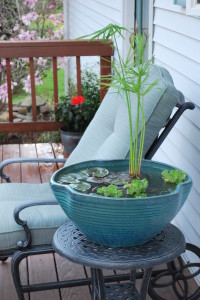 Don't have the space for a pond....ever consider a container water garden? There are many ways to create a small water feature to enjoy and several water plants to consider for a small container.
Don't have the space for a pond....ever consider a container water garden? There are many ways to create a small water feature to enjoy and several water plants to consider for a small container.
Here is a picture of a container water garden and suggestions for plants. You can create one using a filter and water pump or simply create one with just water and plants like this one. This container is approximately 18 inches in diameter and about 10 inches deep. The dwarf water lily and umbrella palm are planted in smaller containers and then the water lettuce and azolla just float on top. Make sure you seal containers on the inside with a concrete sealer or spray urethane and seal any holes in the bottom of the container with clear silicone caulk.
Lotus are very popular water garden plants that are grown in containers. Other plants to consider would be any dwarf or small water lily, dwarf cattails, dwarf papyrus, sweet flag, pickerel rush, umbrella palm or any smaller size plant. Consider using floating plants such as azolla, water lettuce or water hyacinths which will cover the water and help keep it algae free. Using azolla or duckweed creates a blanket of coverage on top of the water.
If you choose to use a larger container and want to add a small pump we recommended a 65 gph pump. https://www.dragonflyaquatics.com/pondmaster-65-gph-pump.html. You can even add some small fish then.
There are endless possibilities when creating a water garden feature. So whether you choose to dig a hole in the yard or one that wishes just to have a small water feature to enjoy, its heaven to simply bask in the quiet tranquility of your own creation whatever it may be.
All plants thrive when given fertilizer. Pond plants aren't any different than our garden plants and flowers. A little tip for your water hyacinths is to take them out of your pond and place them in a tub with water and miracle grow in it. Leave them soak for awhile soaking up the fertilizing in their leaves. Rinse them off and return them to your pond. They will flower more for you. You can also do this when you first receive your plants when re-hydrating them prior to planting them or placing them in your pond.
There are five different types of plants that you will want to add to your pond to provide beauty and help you achieve an ecological balance in your water garden.
Submerged plants such as Anacharis, Vallisneria, Cabomba, Hornwort and Red Ludwigia remove nutrients from the water so algae can’t thrive. Submerged plants do not need soil. Just plant them in one-gallon pots or plant baskets filled with pea gravel and place them in the bottom of your pond. Or purchase plant anchors with your plant order, and simply wrap the weights around the bunch of plants and they will sink to the bottom of the pond.
Water Hyacinth, Water Lettuce, Frog Bit, Parrot’s Feather and Azolla are all members of the floating plant family. Floating plants are very useful in keeping the pond water clean and clear. These are simple plants that free-float and do not need to be potted. You simply toss them into the water garden where they are extremely beneficial to the pond. Floating plants shade the surface and with their roots dangling in the water they pull nutrients from the water essentially starving the algae. They tend to be quite prolific and provide hiding places for baby fish and other water garden inhabitants.
Otherwise known as water lilies, they grow in pots placed 12 to 36 inches deep and have foliage and flowers that bloom on top of the water’s surface. Water lilies provide shade for the fish and add coverage to the water’s surface. Water lilies are available in many different colors and sizes.
Lotus are also considered a hardy water plant that can also be planted deep in your pond and its flowers and leaves will help provide shade and coverage.
Plants such as the hardy canna (Thalia dealbata) grow in mud or 8 to 12 inches deep in the water. Arrange them on platform shelves on the edge of your pond to conceal the water garden’s artificial edges. Plant bog and marginal plants in plastic pots, then place the pot under the water and let the plants grow in the open air. When the plants are young, use care and gradually lower them deeper as the plant matures.
Bog Plants and Marginal Plants
Marginal and bog plants grow in damp soil just outside a pond. They are good transition plants between land and water. Some tolerate completely waterlogged ground and others will not tolerate more than moist soil, check each plant’s requirements carefully.